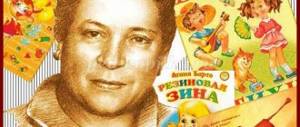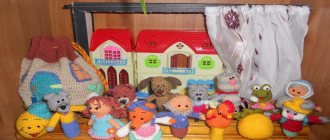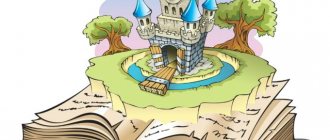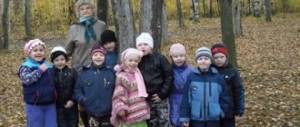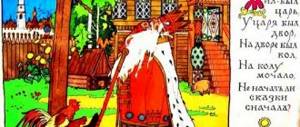Tales of the peoples of the world
Slide 1.music
(Russian folk)
Hello guys!
Today we will go on an exciting journey through the pages of our favorite fairy tales. Do you know that there are up to twenty million fairy tales in the world: folk tales, that is, those composed by many people, and copyright ones, invented by specific authors.
There are fairy tales with Baba Yaga, Koshchei the Immortal, Vasilisa the Beautiful, and the goldfish. There are fairy tales about animals. They are funny and instructive, reminiscent of fables. There are also everyday tales. The heroes in them are kings, soldiers, artisans, and simple peasants. As a rule, a man or an experienced soldier emerges victorious, thanks to his strength, dexterity and ingenuity. Most often, Russian fairy tales are a heroic epic, since at one time Russia had many enemies, then heroic fairy tales showed the strength of the people, their power.
But tell me, what do the fairy tales of the peoples of the world have in common? That's right, good always triumphs over evil. Why do we need to read fairy tales? Because fairy tales collect folk wisdom, teach us goodness and appreciate beauty. No wonder they end with the words: “The fairy tale is a lie, but there is a hint in it - a lesson for good fellows.”
All nations have fairy tales. Today we will learn a little about the fairy tales of some countries.
Slide 2
We will get acquainted with folk tales of the Czech Republic and Dagestan. Let's start, of course, with Russia.
- “Nikita Kozhemyaka”
Slide 3
Folk tales are familiar to everyone, but in science there is no single definition of this genre. In a word, “fairy tale” we call moralizing stories about animals, magical stories full of miracles, intricate adventurous stories, and satirical anecdotes. Each of these types of oral folk prose has its own distinctive features: its own content, its own themes, its own system of images, its own language. And the characteristic feature of a fairy tale is its fiction, in the fact that it is presented by a storyteller and is perceived by listeners primarily as a poetic fiction, a game of fantasy.
Guys, who owns the lines: “What a delight these fairy tales are! Each is a poem!”? If you don’t remember, then this is the great Russian poet Alexander Sergeevich Pushkin. His nanny Arina Rodionovna told him bedtime stories. Perhaps among the poet’s favorite fairy tales was the story of the Russian hero Nikita Kozhemyak.
Slide 4
Now we will watch a very funny and instructive fairy tale, where the main character is Nikita Kozhemyaka.
Slide 5.
Fairy tale
Did you like the fairy tale? Thanks to what qualities did Nikita defeat the dragon? (mind, strength, savvy) Young guys!
Slide 6
Japan is called the Land of the Rising Sun. Poetic, isn't it? Japanese fairy tales differ from Russian ones in their unique philosophy and wisdom.
One of the most famous Japanese fairy tales in Russia is “Three Bunches of Straw” about a brave and kind orphan boy. A cartoon was made based on the fairy tale, which we will see now.
Fairy tale
Slide 8
And now we will talk a little about the Czech Republic. In the Czech Republic there are a lot of fairy tales about animals, various magical legends and legends. Animals in fairy tales sometimes do the same things as people in real life. Most often, actions, of course, are kind. The author's fairy tale about a caring and kind mole is loved not only by children. Adults also enjoy watching it. The fairy tale is called The Mole and the Swallow.
Slide 9.
Fairy tale
After watching: Would you like a friend like a cute mole? Why do you like him?
Slide 10
Tales about animals are also popular in Belarus. Belarus is our close neighbor and friend. It is undoubtedly similar to our country. The tales of all Slavic peoples are very close to each other, but at the same time they are deeply different, since they reflect the life of the environment in which they exist, the history of the people who created and preserved them, a certain historical reality. Therefore, Russia and Belarus have a lot in common, and this also applies to fairy tales. Only Belarusian fairy tales are a little different, because they have their own history and their own heroes. These Slavic people love satirical tales that ridicule greed, stubbornness and stupidity. Let's get acquainted with one of these fairy tales. It's called "How the Lord Was a Horse."
Fairy tale
Video. After watching: Pan, this is like our Russian boyar. The owner of a large estate and a noble man. Why did the brownie punish him? For greed, malice and unwillingness to help. Only when I found myself in someone else’s shoes did I realize that I couldn’t do that. After all, all the evil and inattention that we show to people will return to us.
Slide 12
Here we come to the last country for today. This is Dagestan. Neighboring republic. Dagestan fairy tales are interesting because of their original culture and traditions. They are instructive. More often, the heroes of such fairy tales are heroes who selflessly serve people, conscientious workers or wise girls. Stories about amazing travels, about solving difficult problems, about the wit and resourcefulness of the main character. But now we will look at the fairy tale about Shaidula the lazy man. And then you will tell me why this hero was punished.
Fairy tale
Slide 14
So, why was Shaidula punished?
That's right, for laziness and stupidity, as well as for unwillingness to follow smart advice. After all, the tree and the fish said to him: help us and you will prosper. By the way, the most favorite proverbs among the Dagestan people are: “To achieve honors and greatness, force yourself to work.” “Labor and patience turn into gold.”
Read fairy tales, learn from them to be kinder and fairer!
Slide 15
So our little journey through fairy tales has come to an end. We visited only five countries. But you have the opportunity to continue the journey on your own. Read fairy tales, learn from them to be kinder and fairer. Learn life wisdom from them.
We play with fairy tales. Tales of the peoples of the world.
Let us talk today about how fairy tales unite us! Us is all the people on the planet. Despite the fact that we are so different, we have fairy tales with the help of which we want to convey to our children what good and evil are, what generosity and greed are, what true beauty and love are, and precisely because we have goals are all the same, then the fairy tales are very similar.
To begin with, I propose to find such fairy tales and get acquainted with them, and then I will tell you how we will play them.
- A.S. Pushkin “The Tale of the Fisherman and the Fish” (Russia), Brothers Grimm “About the Fisherman and His Wife” (Germany)
- Charles Perrault “Cinderella” (France), Brothers Grimm “Mistress Blizzard” (Germany), S.Ya. Marshak “Twelve Months” (Russia)
- A.S. Pushkin “The Tale of the Dead Princess and the Seven Knights” (Russia), Ch. Perrault “The Sleeping Beauty” (France), The Brothers Grimm “Snow White and the Seven Dwarfs” (Germany)
- S.T. Aksakov “The Scarlet Flower” (Russia), “Beauty and the Beast” (France).
- K. Collodi “The Adventures of Pinocchio” (Italy), A.N. Tolstoy “The Golden Key, or the Adventures of Pinocchio” (Russia).
- Hugh Lofting "Doctor Dolittle" (England), K.I. Chukovsky “Doctor Aibolit” (Russia).
- L.F. Baum “The Wonderful Wizard of Oz” (England), A.M. Volkov “The Wizard of the Emerald City” (Russia).
I have outlined only a small part of similar fairy tales from different authors from different countries. Let your first exciting game with your child be an independent search for similar fairy tales and plots. These may be fairy tales that are different in plot, but similar in meaning, for example, “The Frog Princess” and “The Nutcracker”; in both fairy tales, the main characters are hidden under the mask of a frog and an ugly doll, but someone appears who believes in them and helps them find their true face.
After the fairy tales have been found, you can start looking for differences between them (since we have already found similarities).
Well, now play!
Let's have a guessing . Firstly, you can show each other small scenes from different books (only for this you need to read them). For example, you read “Doctor Aibolit” and “Doctor Dolittle”. Write the name of the fairy tale on a piece of paper (this will help you practice reading) and invite the child to take out the piece of paper with the fairy tale. The child reads it and shows a small scene so that you understand which of the 2 fairy tales we are talking about (the older the child is and the more fairy tales you have read, the more inscriptions you will see). So the kid pulled out a fairy tale about Aibolit, what can he show you? For example, how Aibolitu’s jackal galloped up (in an English fairy tale, a swallow flew to the doctor).
If the child is too small to show scenes, then play with the illustrations. In the same way, to begin with, you can take 2 similar fairy tales, lay out several illustrations of each of them in front of him and ask him to find illustrations of a specific fairy tale. For example, can you guess which fairy tales these illustrations are from, which one is from Aibolit, and which one is from Doctor Dolittle?
Next game, we will create our own fairy tales based on fairy tales by authors from different countries . For example, let's take fairy tales about sleeping princesses (Russian, French and German). Let's read each of them carefully, and then invite the child to come up with his own plot based on all these fairy tales. For example, the evil queen will put Snow White to sleep with a spindle, not an apple, and the prince will be helped to find the princess not by the wind, but by the gnomes. You can weave in your characters and change events in a way that your child will like best, the main thing is to take something from each fairy tale.
The next game will be similar to the previous one, only we will use various illustrations for fairy tales to compose our own . Take (find on the Internet) illustrations from the fairy tales The Scarlet Flower and Beauty and the Beast, print them out and mix them up, and then invite your child to choose illustrations, put them in a chain and tell a fairy tale based on them (since the plots of the fairy tales are slightly different, you may succeed an unusual symbiosis of fairy tales from two countries).
Let's try to guess fairy tales by telling each other only a few adjectives. You can start with 5, gradually reducing their number. For example, long-nosed, wooden, naughty. Two characters immediately appear in my head: Pinocchio and Pinocchio. This means that you need another sign that will indicate differences (you can use not only adjectives here), for example, if he lies, his nose grows. The answer is obvious - Pinocchio, since Pinocchio's nose did not grow, it always remained the same.
The more similar fairy tales by authors from different countries you find, the more opportunities for games you will have. It is very interesting to read not only original fairy tales, but also folk tales. They seem to contain magic from the lives of people who lived a long time ago. For example, the Australian fairy tale “How the Moon Came” shows us what people believed many, many hundreds of years ago and how they explained natural phenomena. And South American fairy tales are distinguished by their stories about animals and their explanations of why they are the way they are. The tales of the peoples of Africa seem to me the most mysterious, but also the most cruel, but this is easily explained. After all, they have a very difficult way of life (among African tribes) and their whole life is a struggle. Read with your child folk tales that came to us from different continents and try to understand why they are the way they are, what left their mark on them.
How do you play with fairy tales?
PS This article is copyrighted and is entirely intended exclusively for private use; publication and use of it on other sites or forums is possible only with my written consent. Use for commercial purposes is strictly prohibited. All rights reserved. Author: Maria Kostyuchenko. Online school “Learning by playing”
You might be interested in:
Fun break. Flower children
Thematic games for the project “The Wizard of Oz”
Maslenitsa quests for children
